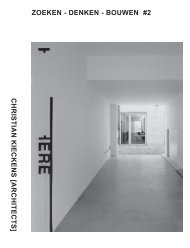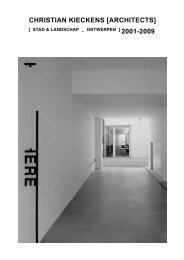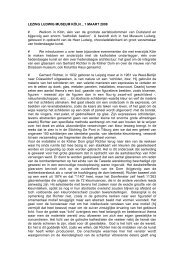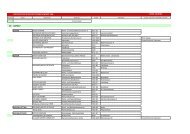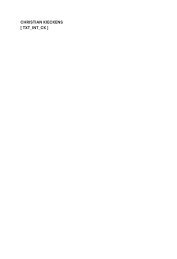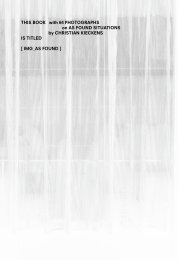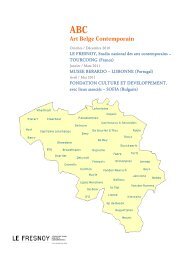03.03 > 07.03.2008 - Christian Kieckens Architects
03.03 > 07.03.2008 - Christian Kieckens Architects
03.03 > 07.03.2008 - Christian Kieckens Architects
You also want an ePaper? Increase the reach of your titles
YUMPU automatically turns print PDFs into web optimized ePapers that Google loves.
Sang LEE<br />
Rik NYS<br />
Dieter VANDOREN<br />
_ Sang LEE, M. Arch. degree from the University of Pennsylvania. Lecturer of<br />
Architecture and coordinator of the US-EU exchange program at the School of<br />
Design, the University of Pennsylvania 2000-2003. Visiting Lecturer at the Bauhaus<br />
Summer Academy in Rome in 1999, 2000 and 2003. Guest critic at Columbia<br />
University, Pratt Institute, Temple University, UCLA and Sci-ARC. Professional<br />
experiences working with Daniel Libeskind, Robert Venturi and William McDonough.<br />
Currently teaching at TU Delft.<br />
_ Dieter VANDOREN studied communication and information at the University of<br />
Utrecht. He has been active as an artist in electronic music venues in the<br />
Netherlands and Belgium and participated in music installation projects, most<br />
recently in association with Kas Oosterhuis during the Rotterdam Architecture<br />
Biennale. Vandoren’s expertise includes electronic music composition using digital<br />
applications and audio-visual production.<br />
_ °1962. Senior Lecturer and MA Pathway Leader Architecture and Interior Design,<br />
Department of Architecture and Spatial Design, London Metropolitan University.<br />
Visiting Professor Facoltà di Architettura, Universtà degli Studi di Napoli.<br />
Director Research Unit RU2. Collaborator Special Projects, David Chipperfield<br />
<strong>Architects</strong>. Trained as an architect at the Saint Lucas Institute Ghent and the<br />
Architectural Association in London.<br />
Urban Contingencies and<br />
Aggregate Accumulation<br />
The workshop focuses on the use of digital technology in architectural design<br />
and production by investigating what can be termed as the “everyday” and its<br />
contingent conditions. The day-to-day condition is today exemplified in a highly<br />
dynamic flux of mediatization and its potential link to architectonics that can<br />
actually retain and reflect the vitality of such measure. Even though the everydayness<br />
is a cyclical one, the contingencies of each day mandate one to consider<br />
the permutations implied in each turn. The application of digital technology is in<br />
this sense regarded as an intervening of “apparatus” in architectural design and<br />
production. In apparatus architecture, the techné is all at once the episteme.<br />
We will focus on apparatus driven design and production techniques by focusing<br />
on the production of the basic aggregate and its codification. The primary<br />
objective is to produce the corollary of digital technology, the conception and<br />
production of architectonic codification, and ultimately to propose a strategy of<br />
architectural construct that has given way from the clarity of static geometry to<br />
the complexity in dynamic variability, that of aggregate accumulation.<br />
The workshop deals with the relationship between the tactile consideration of<br />
making and how it can be interfaced to and further implemented by means<br />
of the digital technology. The initial process will be centered on the physical<br />
construction of an aggregate unit as a pretext to its accumulated effects in<br />
a structural configuration. Subsequently the investigation will be focused on<br />
how the aggregates can be assembled and uniformly transformed according<br />
to given indices.<br />
12<br />
Light less light<br />
The workshop aims to create a series of physical models exploring light and<br />
space making. As maquettes, these models can be described as hybrids<br />
of well-known and established typologies. They oscillate: between Wendy<br />
Houses and theatrical sceneries; between architectural Follies and carved<br />
grottos; between pinhole cameras and Boîtes à Magic…<br />
Alice in Wonderland is part of the story and an extended use of all traditional<br />
scales of model making is key to the development of the project. The<br />
ultimate goal is to experiment with space and light with the assistance of<br />
a digital camera. Today’s cameras offer an extreme depth of field, capable<br />
of mimicking the scale of human inhabitation related to the horizon of the<br />
human eye. The outcome of the workshop is intended to result in a series<br />
of large prints, which express a sensibility concerned with precise light and<br />
pure space.<br />
13



